
The Lingayen Gulf is a large gulf on northwestern Luzon in the Philippines, stretching 56 km (35 mi). It is framed by the provinces of Pangasinan and La Union and sits between the Zambales Mountains and the Cordillera Central. The Agno River drains into Lingayen Gulf.

Anda, officially the Municipality of Anda,, is a 3rd class municipality in the province of Pangasinan, Philippines. According to the 2015 census, it has a population of 39,504 people.
The people of Anda generally speak Pangasinan, Bolinao, and Ilocano.
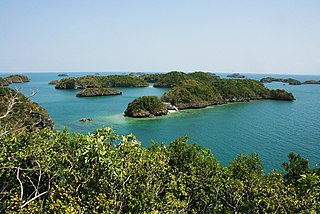
The Hundred Islands National Park is the first national park and a protected area located in Alaminos, Pangasinan in the northern Philippines. The islands, totaling 124 at low tide and 123 at high tide, are scattered in Lingayen Gulf covering an area of 16.76 square kilometres (6.47 sq mi). Only three of them have been developed for tourism: Governor Island, Quezon Island, and Children's Island.

Pangasinan is a province in the Philippines. Its provincial capital is Lingayen. Pangasinan is on the western area of the island of Luzon along the Lingayen Gulf and West Philippine Sea. It has a total land area of 5,451.01 square kilometres (2,104.65 sq mi). According to the 2015 census, it has a population of 2,956,726 people. The official number of registered voters in Pangasinan is 1,651,814.

Agno, officially the Municipality of Agno,, is a 3rd class municipality in the province of Pangasinan, Philippines. According to the 2015 census, it has a population of 28,052 people.
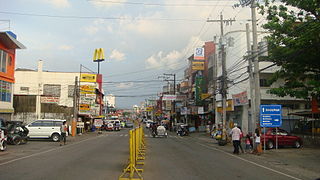
Alaminos, officially the City of Alaminos,, or simply known as Alaminos City is a city in the province of Pangasinan, Philippines, and is known for being the home of the Hundred Islands National Park, which is composed of 124 islands and is located off the coast of Barangay Lucap. Alaminos is classified as a 4th class city. According to the 2015 census, it has a population of 89,708 people. The city was named after Juan Alaminos y de Vivar, former Governor-General of the Philippines.

Bani, officially the Municipality of Bani,, is a 2nd class municipality in the province of Pangasinan, Philippines. According to the 2015 census, it has a population of 50,306 people.
It is located between Alaminos City and Bolinao and is named after the Bani, tree which could be found in the Poblacion. Dubbed as the "Golden West" in the 1960s and early 1970s, Bani lies between Tambac Bay and West Philippine Sea. Bani has a land area of 19,243.6075 hectares.

Bugallon, officially the Municipality of Bugallon,, is a 2nd class municipality in the province of Pangasinan, Philippines. According to the 2015 census, it has a population of 67,348 people.
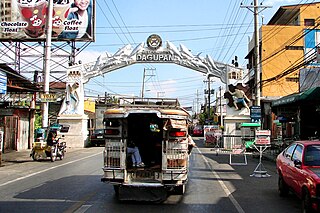
Dagupan, officially the City of Dagupan, or simply Dagupan City, is a 1st Class independent component city in the province of Pangasinan, Philippines. According to the 2015 census, it has a population of 171,271 people.
The Legislative Districts of Pangasinan, namely the first, second, third, fourth, fifth and sixth districts, are the representations of the Province of Pangasinan and the independent city of Dagupan in the Philippine House of Representatives. Pangasinan was divided into five legislative districts from 1907 to 1972, it was redistricted into six legislative districts in 1986. It was part of the representation of Region I from 1978 to 1984, and from 1984 to 1986 it elected 6 assemblymen at-large.

Victory Liner, Inc. (VLI) is one of the largest provincial bus companies operating in the Philippines, servicing routes mainly to the provinces of Central Luzon which includes Zambales, Pampanga, Bulacan and Northern Luzon which includes Benguet, Pangasinan, Bataan, Nueva Vizcaya, Kalinga, Isabela and Cagayan. This bus company played a major role in transport industry since it became the product of Japanese occupation in the country after World War II, with used Chevy trucks from the United States Army as their primary transportation fleet.
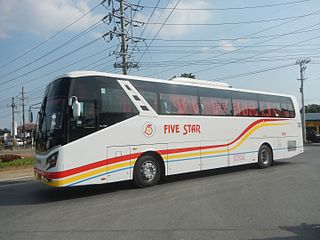
Pangasinan Five Star Bus Company, Incorporated, or simply known as Five Star, is one of the largest bus companies in the Philippines. It serves routes mainly to the provinces of Pangasinan, Nueva Ecija, Tarlac, Nueva Vizcaya, Quirino, Isabela and Cagayan Since it took management of at least three bus companies which includes Bataan Transit, First North Luzon Transit and the 2010 Luzon Cisco Transport, Five Star has been one of the most successful bus companies in the Philippines.
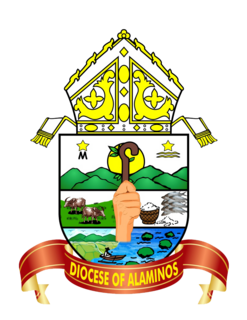
The Roman Catholic Diocese of Alaminos is a Roman Rite diocese of the Latin Church of the Catholic Church in the Philippines.

Pangasinan State University, The university was founded in its current form in 1979, although its origins trace back to the 1920s. PSU is notable for its many locations throughout the province of Pangasinan. It is mandated to provide advanced instruction in the arts, agricultural and natural sciences as well as in technological and professional fields. Its main campus is located in Lingayen, Pangasinan. Other campuses are located in Alaminos City, Asingan, Bayambang, Binmaley, Infanta, San Carlos City, Santa Maria, and Urdaneta City. The PSU Graduate School is located in Urdaneta City and the Open University Systems (OUS) is located in Lingayen Campus and Binmaley Campus.
The Alaminos Airport in the Philippines got its approval in 2007, but its location was not decided upon until 2009 within the area of Alaminos, Pangasinan. Construction began in March 2010 and it was expected to open for domestic flights by 2012-13, but then set for 2016-17 and for international flights by 2022, encompassing an area of 158.5 ha within the barangays of Sabangan, Pandan, and Telbang. It has an estimated cost of 3.9 billion Philippine pesos. Currently the project has been stalled for various reasons.

City Supermarket, Inc. (CSI) is a retailer under the CSI Group of Companies based in Dagupan City, Pangasinan, Philippines. It is the largest retailer in Northern Luzon.
One Pangasinan Alliance or OPAL (DMA) is an economic alliance of six towns and one city of western Pangasinan, representing the 1st District of Pangasinan. It is composed of Alaminos City, Agno, Anda, Bani, Bolinao, Burgos, Dasol, Infanta, Mabini & Sual
The Most Reverend Marlo Mendoza Peralta, D.D., is a prelate of the Roman Catholic Church in the Philippines. He is the current Archbishop of Nueva Segovia in the Philippines.

Juan Alaminos y de Vivar (1813–1899) was a Spanish general who served as the 96th Governor-General of the Philippines.

Luzon Cisco Transport, Incorporated or simply known as Cisco Bus is a provincial bus company in the Philippines by the Hernandez Clan, and had service to Nueva Ecija, Pangasinan and Zambales


















